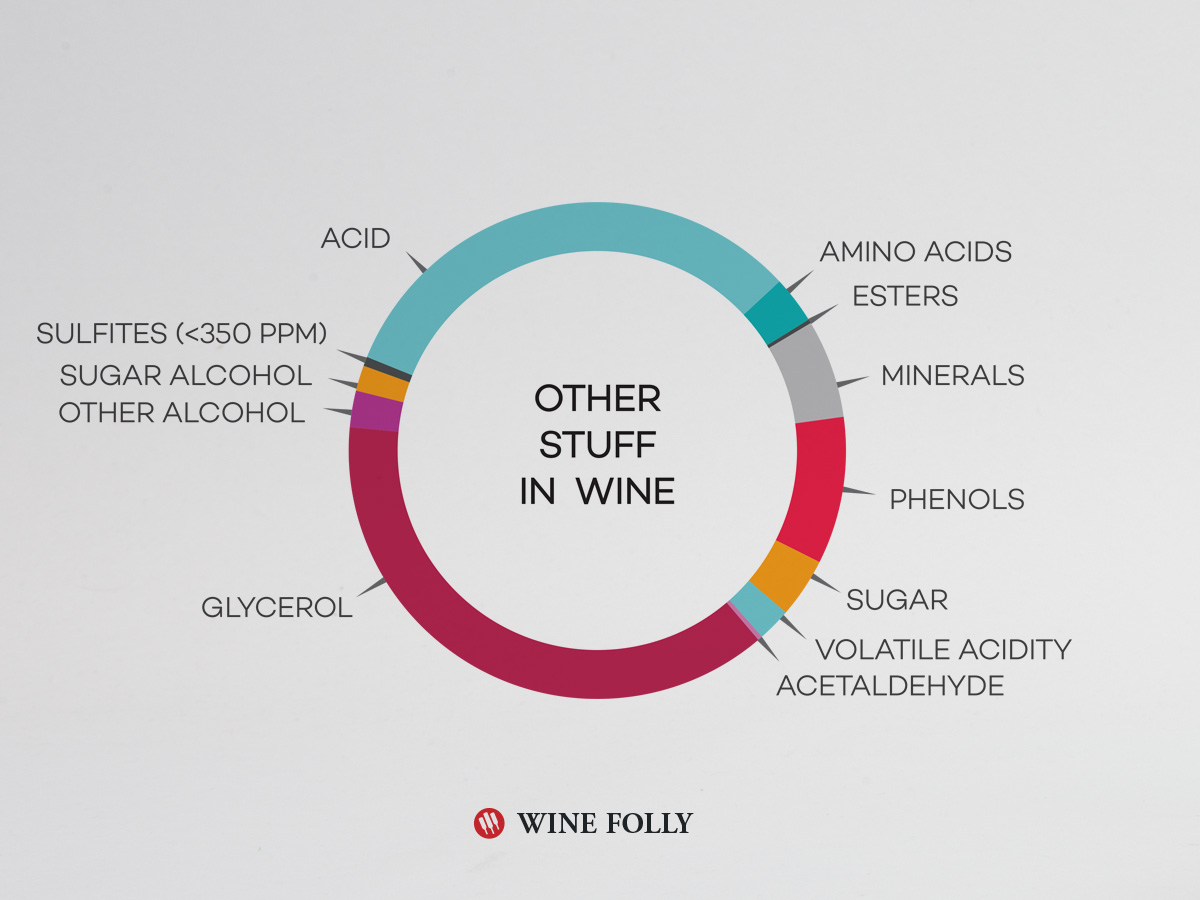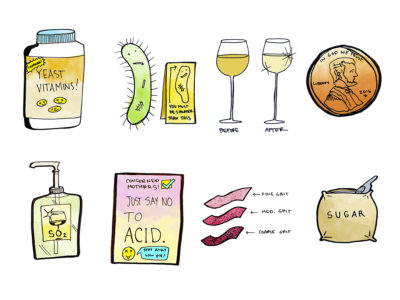Question: What’s inside a glass of wine? Is it really just grapes or are there other ingredients added to make it taste the way it does?
Short Answer:
Wine is made with grapes and the various fruit flavors we taste come from the process of making wine (and aren’t blended in!).
This question points out the fact that wines are often described as having specific identifiable flavors such as black currant, cherry or vanilla. Let’s find out what’s inside a glass of wine, from the chemical compounds that give wine its unique taste, to the levels of common additives used to stabilize and preserve wine.
What’s inside a glass of wine?
What about calories? Yes. Wine contains calories. Find out how much
When you look at the contents of wine it’s mostly water, followed by ethanol alcohol which is what makes you drunk! What’s fascinating is that everything else–the color, the taste, the aroma,– comes from a tiny fraction of “other stuff.” This is where wine starts to get interesting.
“Other Stuff” in Wine
Wine would be boring if it weren’t for a tiny fraction of “other stuff” that accounts for all the aromas, the color and the unique taste.

pie chart from page 5 in Wine Folly: The Essential Guide to Wine
-
Acid
- Wine lies on the acidic side of the pH spectrum. This is because wine grapes contain acid and these acids transfer into the wine. Acidity in wines range from super sour at around 2.5 pH (high acidity) to very flat at around 4.5 pH (low acidity). You’ll notice that white wines tend to have higher acidity than red wines.
-
Amino Acids
- There is a very tiny amount of amino acids found in wine composed of mainly proline and arginine. While these two amino acids have been noted for some health benefits, their concentration in wine is too small to cause much affect.
-
Esters
- Esters contribute to the aromas in wine. They are created when acids react to alcohol and change slowly as the wine evolves over time. Esters contribute most notably green apple and flower-like flavors in white wines and strawberry and raspberry-like flavors in red wines. Esters are dependent on the yeast used to ferment the wine and the temperature of the fermentation. For example, the “banana” smell found in some red and white wines is caused by an ester called isoamyl acetate that often forms at higher fermentation temperatures.
-
Minerals
- Wines contain several minerals including iron, magnesium, potassium, calcium, zinc, phosphorus and manganese. Despite the presence of these minerals in wine, they do not contribute to the taste of minerality in wine. A glass of wine will, however, give you about 4% of your daily diet of iron, magnesium and potassium. Generally speaking, white wines contain less minerals than red wines.
-
Phenols
- Phenols are a large group of chemical compounds that contribute a wide range of aromas and tastes in wine (including tannin!). Phenols come from several sources including the wine grapes themselves and the process of aging wine. For example, one of the key compounds that delivers the “violet” aroma in fine red wines is caused by a compound called Phenylethanol. Another compound is the aroma of “clove” or “cola” that’s often described in oak-aged Pinot Noir and is caused by aging the wine in oak.
-
Sugar
- When not all of the grape’s sugars are fermented into alcohol then the wine is left with sweetness called residual sugar or “RS” for short. Sweetness in wine ranges from just a couple of calories per glass to a wine that has the thickness of maple syrup from leftover sugars.
-
Volatile Acidity
- Unlike standard acidity and pH in wine, there is another group of volatile acids that can cause pungent, rancid-smelling aromas and flavors. This group of acids is led by acetic acid (the acid that makes wine turn to vinegar) but also includes hexanoic acid (sweaty/cheesy) and propionic acid (cheesy smell in Champagne or white Burgundy).
-
Acetaldehyde
- Acetaldehyde is a volatile compound that is sometimes described as having a yellow apple-like aroma. Acetaldehyde is caused primarily from oxidation in the winemaking process. In most wines there are very trace amounts of Acetaldehyde (30–80 mg/L), except for Sherry, which has about 300 mg/L due to its oxygen-friendly winemaking process.
-
Glycerol
- Glycerol is a sugar alcohol that can be found in mild amounts (about 4–10 g/L) in dry wines and moderate amounts (20+ g/L) in sweet wines made with noble rot. Although glycerol isn’t technically sugar, it does contribute to the sweet fruity quality in many wines.
-
Higher Alcohols
- These alcohols are found in minuscule amounts in wine and are said to contribute to a range of aromas from grassy green aromas to meaty sulfur-based alcohols. Many of these are too small to notice and simply work as a contributor defining a wine’s primary aromas.
-
Sulfites
- Sulfites are a preservative added to wine. They do not add a flavors to a wine and are legally required to be less than 350 parts per million. As a general rule, white wines tend to contain more sulfites than red wines; and sweet wine contains more sulfites than dry wines. Read more in “The Bottom Line on Sulfites in Wine”

What about wine additives?
You may have heard stories about wine additives. So what are they exactly? Here’s an article about the most common additives in wine and whether or not they are good or bad for you.
